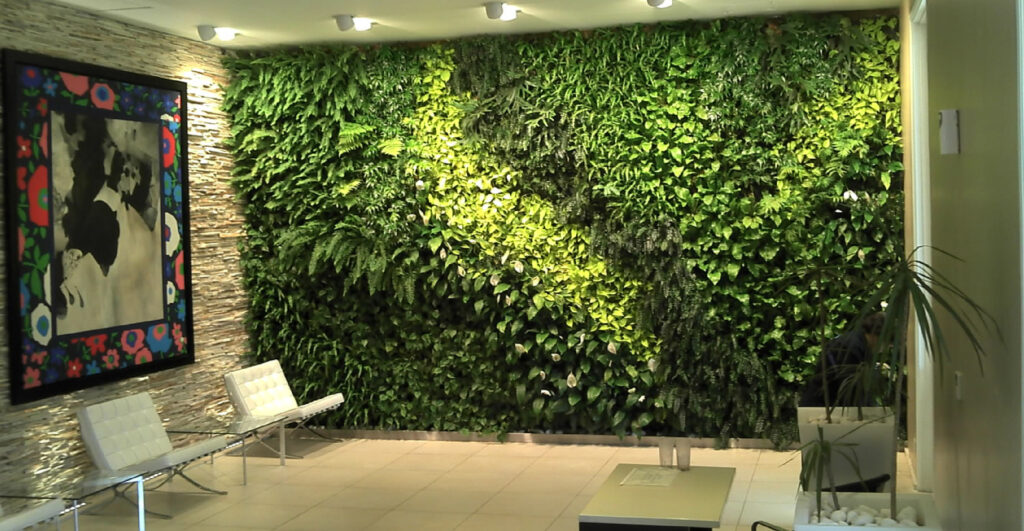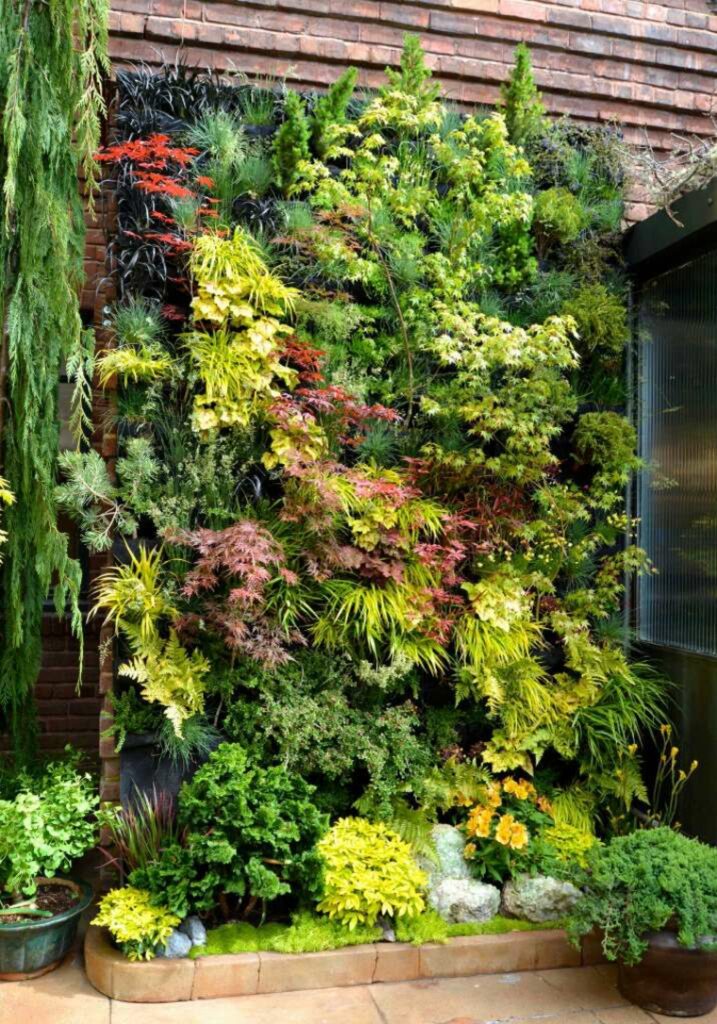You may love plants and want to have a garden, but you're short on yard space or live in an apartment. Well, it turns out that now there is the possibility of having a garden in a few meters. You ask how? On a wall or other vertical element. Here we present how to make a Vertical Garden, with natural and artificial plants. So you no longer have excuses, I invite you to read more about it.

Vertical, Natural and Artificial Gardens
Vertical gardens are gaining ground every day among landscape architects, gardeners and plant lovers. In the cities some landscaping of companies or public places with beautiful vertical gardens are observed, one more beautiful than others. Would you like to have one at home? On that empty wall that you still wonder what to do on it. What do you do if you live in an apartment and want to have a vertical garden? The good news is that you can also build a vertical garden indoors, with artificial plants.
To achieve this, you first have to know what a vertical garden is all about. At first, what you see is a vertical green wall due to the number of plants you see. When detailing it you will be able to observe that it consists of a vertical installation in which the selected plants are placed. It should be noted that the chosen plants must have similar habitat, light, water and nutrient requirements, to which constant maintenance is done to control pests and diseases.
Considerations to install a Vertical Garden
- First of all, properly select the plants to plant in the vertical garden. It is convenient to select plants with similar requirements to make their maintenance easier.
- Just as you have to select the plants, you also have to take into account the environmental conditions such as light, temperature, humidity, among other factors of the place where the vertical garden will be installed.
- Place a meter that monitors factors such as salinity, solar radiation, gas exchange, or others. In order to detect any imbalance that occurs in the vertical garden.
Benefits of a Natural Vertical Garden
Vertical gardens or vegetable walls are traditionally made with climbing plants or vines such as ivy, honeysuckle or jasmine. Decorating and upholstering the walls, walls and railings that help cool the temperature in summer.
They are an option to have a garden in small spaces outside the house. This is because one wall is covered with plants and it clears floor space that can be used for options. Having a vertical garden allows you to have a space surrounded by vegetation in the city.
Vertical gardens provide isolation, they offer you a beautiful vertical spectacle that serves as a separation wall between neighboring houses or the street. It also helps protect the home from the elements and changes in the weather, such as from the sun's rays.
Designers and architects who design and build vertical gardens like to use bromeliads, peperomia plants and any other small-sized plants, in addition to these, they also like succulents and aromatic plants, since these plants are of relative importance. low maintenance and small in size, they are very pretty and give off a pleasant aroma.
If you are concerned about building a vertical garden in a place inside the house, because you have a good entry of light through a nearby window or an internal patio, make a design of the vertical garden with the arrangement of plants that grow well under shade, according to leaf shapes and colors or other characteristics. This will help you create a unique vertical garden that beautifies and improves the atmosphere of the house.
To avoid problems of moisture on the wall where the vertical garden is installed, the expert architect in interior design and vertical gardens, Erick Millan, suggests placing a sheet of wood against plywood, varnished with a water sealant, which protects the wall from the living place. It is an additional step and generates more cost but it solves a future problem.
Benefits of an Artificial Vertical Garden
You have doubts about building a vertical garden inside the house because you have little time to take care of it or you do not know how to do it. I tell you, that it is possible to have an interior garden on your wall, using 100% natural plants, which do not require water and any type of maintenance. These types of plants can be purchased in shops in some countries. These preserved natural plants are the result of a restoration process with glycerin and no chemical substances are applied.
Another advantage of growing a vertical garden is that you can do it with artificial plants, which are cheaper than the previous ones and, currently, there are some very well made ones. In maintenance of an artificial vertical garden it is practically nil because, you do not have to be aware of the presence of pests or diseases, your plants will maintain the same appearance all the time and, especially if you invested a little more in acquiring good quality artificial plants. , which keep their color longer.
How to build a Vertical Garden
To build a vertical garden you don't have to do it with geotextile mesh and a specific design for a vertical garden, you can manage and design a vertical wall, using the installation with hanging planters, for this you will have to have a base that serves as a grid and some sturdy hooks with which to hang the pots.
Years ago, when plant walls became fashionable, many people wanted to have one in their homes. At that time, the landscaper Patrick Blanc indicated that the plants used did not require soil, but simply water, nutrients, light and aeration. However, he failed to indicate that the installation of an expensive and complicated irrigation system was essential. That was an obstacle years ago to build a vertical garden.
Since experience makes a difference, today there are more options in terms of the size of vertical gardens, the place to build one, outside or inside the houses, in addition, many succulent and aromatic plants are known that you can use in that vertical garden. that you want so much The key is to have a wall that receives little direct sunlight, even outside, so that the temperature of the wall is not so high. The rest is to follow the instructions.
- To start, you must first have a design for the garden, you can choose pots, pallets, creating daring designs.
- To build the vertical garden before planting, the selected wall is covered with a sheet of an impermeable material such as a plastic sheet.
- After the waterproof sheet is placed, two layers of geotextile are applied to which several cuts are made, inside these cuts mosses are placed from the roots of the plants.
- To water the plants, a drip irrigation system is installed, to prevent water from falling on the floor, it is suggested to place a tray or bucket while watering and leave it for an hour after finishing watering. To avoid watering and maintaining the plants, there are also gardens with artificial plants.
- Depending on the design that you have devised, you will select the type of plants to place, without they are dark green light green foliage plants, with red, yellow or white flowers, as long as aesthetic harmony and coexistence between them is achieved.
- Of course, when designing the vertical garden, the selected place must be taken into consideration, whether in an outdoor or indoor space, because in addition to the aesthetic aspect, the selection of plants must take into account the sunlight that arrives. to the wall. You also have to consider the water requirements.
- So you also have to consider which substrate to use, whether it is using soil, hydroponics. Due to weight, it is recommended to use the hydroponic substrate, because it weighs less than the soil substrates and it pollutes less. It saves more irrigation water and sows more plants in fewer spaces.
- Once the previous steps have been considered, what has to be done is the installation of the vertical garden.
Build an Indoor Vertical Garden
Before starting to install a vertical garden in an interior space, you have to choose the elements that are going to compose it. You are suggested to choose between pallets, bamboo, wood, pots of different sizes and shapes. Gardening tools, glue, silicone, scissors, saws and of course the plants.
Among the plants that you can use are suggested: Anthuriums; Ferns; bromeliads; Cineraries; Peperomias; Boat Girls (Tradescantia pallida); the succulents Millionaires or rocios; among other.
Choose a wall that is resistant and you can install the vertical garden without damaging the wall. Choose a structure where you will place the plants, It is suggested to use glass, or pocket-type structures where you will plant the plants. It is suggested that the plants you select be small with a maximum height of 15 centimeters when they grow so that the desired visual effect is achieved.
For a good amount of light to reach it, the place to install the vertical garden must be near a window, a skylight or an interior patio. Remember, the plants preferably have to have similar water requirements and complement each other by their colors. The place where you place your vertical garden can be used as a reading corner, to practice yoga, or a place to rest.
Build an Artificial Vertical Garden
The advantage of building an artificial vertical garden is that it is cheaper and you can even build it yourself. By following these steps and selecting good artificial plants, you will manage to have a beautiful vertical garden and surprise many. Follow the steps:
- Select the types of artificial plants and also how many you want to have. You can select plants where flowers, leaves and also mosses stand out. I suggest you make sure they are of good quality. They look very similar to the natural
- Have sheets of wood, cork or acrylic on which you will paste the selected plants and according to the elaborate design. The selected support material must be resistant but not very thick, so that the plants stand out. Also remember to have a glue, silicone and adhesive so that the plants last a long time attached to the support and are waterproof, especially if you are going to place it outside the home.
- Once the plants are placed on the sheet, you can also add some complementary elements, they can be ornaments alluding to the decoration of the environment. In case you place it outside, you can add some natural plants of the season, which you will change when the season changes. This will make your vertical garden dynamic with artificial plants.
Once you have built your vertical garden, I hope you enjoy it and it becomes your favorite place due to the sensation of peace that the plants feel when they are dry. Also, as long as you keep your design, you can change the plants according to the season, as long as you keep it careful, respecting the balance of the garden and the plants.
I invite you to continue learning about plants, follow the following posts:


